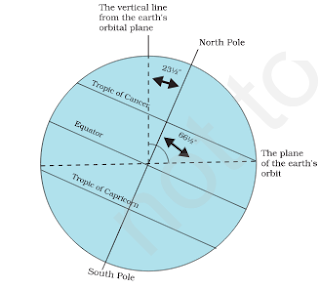 |
| Revolution and Change in the Seaosns |
The movement of Earth on its axis is called Rotation.
Revolution
The movement of Earth around the Sun in a fixed orbit is called Revolution.
Orbital Plane
The imaginary plane formed by the orbit is known as the orbital plane. The axis of Earth makes an angle of 66.6° with its orbital plane.
 |
| Inclination of Earth |
Due to its spherical shape, only half of the Earth experiences Sun (or Day) at a time, other half experiences night. The imaginary circle which divides Earth into halves of day and night is known as the circle of illumination.
Day and Year
Earth takes about 24 hours to complete its one rotation. It is known as Earth Day.
Earth takes 365 days and 6 hours to complete its one revolution. For the sake of convenience, we ignore 6 hours and consider 365 days as a year. But, surplus 6 hours are added to make one day (24 hours) over a period of every four years. This surplus day is added to the month of February. This result in a year of 366
Seasons
Earth moves around the Sun in an elliptical orbit. This means the distance between Earth and the Sun is never a constant. This change causes the change in seasons. The four major seasons are summer, winter, spring and autumn.
Summer Solstice
On 21st June, the Northern Hemisphere is tilted towards the Sun and sunrays directly falls on the Tropic of Cancer. As a result, this area receives more light and heat. The day is longest and night is the shortest in Northern Hemisphere. This phenomenon is known as the Summer Solstice. Since a large portion of Northern Hemisphere receives heat and light from Sun during this period, it is Summer in the Northern Hemisphere. The conditions are the exact opposite in Southern Hemisphere and it experiences Winter during this period.
Winter Solstice
On 22nd December, the Southern Hemisphere is tilted towards the Sun and sunrays directly falls on the Tropic of Capricorn. As a result, Southern Hemisphere receives more light and heat. The day is longest and night is the shortest in Southern Hemisphere and the reverse is happening in Northern Hemisphere. This phenomenon is known as the Winter Solstice. Since a large portion of Southern Hemisphere receives heat and light from Sun during this period, it is Summer in the Southern Hemisphere and Winter in the Northern Hemisphere.
Equinox
On 21st March and September 23rd, sun rays directly fall on the equator. At this position, neither of the poles are tilted toward Sun. The whole earth experience equal day and equal night. This phenomenon is known as Equinox.
Source: NCERT Class 6 Geography
